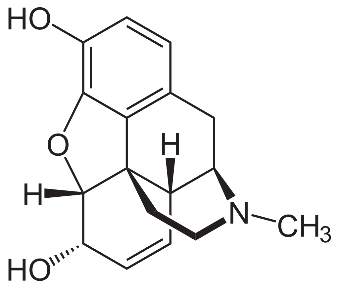Morphine Analysis Service
Submit Your InquiryOverview
Morphine and its derivatives exert their biological effects by acting at the relevant receptors. Morphine is primarily bound to glucosinolates in the liver and produces two metabolites, morphine 3 glucosinolate (M3G) and morphine 6 glucosinolate (M6G). The metabolism of morphine occurs not only in the liver, but also in the brain and kidneys. Morphine can be used to treat acute left heart failure based on its venodilatory effect, reducing the anterior and posterior cardiac load and improving cardiac function. In addition, morphine has a sedative and analgesic effect to relieve irritability, anxiety and fear, which can inhibit sympathetic hyperactivity, reduce oxygen consumption and improve patients' symptoms of dyspnea. It also excites smooth muscle, increases intestinal smooth muscle tone causing constipation, and increases smooth muscle tone in the bile duct, ureter and bronchus.
Opioids represented by morphine are considered to be the drugs of choice for the treatment of pain. Some morphine derivatives have been developed with greater potency and less adverse effects, such as hydromorphone hydrochloride, which has less metabolite accumulation and does not suppress the immune system.
 Molecular structure of morphine
Molecular structure of morphine
Creative Proteomics has high performance liquid chromatography (HPLC) and liquid phase mass spectrometry (LC-MS) detection platforms to enable qualitative and quantitative morphine assay services. We can detect morphine, morphine metabolites and morphine derivatives. In addition, we offer a variety of other alkaloid assays to meet your different needs.
Platform
- HLPC
- LC-MS/MS
- NMR
Workflow of Targeted Metabolomics Service of Morphine
Targeted metabolomics is a study that identifies and quantitatively analyzes known metabolites in a sample. Its advantages are high specificity and accuracy. Therefore, this method has been widely used to analyze and compare multiple target metabolites in different physiological states.

Sample Requirements
- Tissue ≥ 200 mg/sample
- Plasma ≥ 200 μL/sample
- Blood ≥ 200 μL/sample
- Drugs ≥ 0.2 g/sample
We can also accept other samples. Please contact us for the exact sample size required for the test.
In order to ensure the accuracy of the samples and reduce systematic errors during sampling, it is necessary to select more than 3 materials with the same condition for each sample. The same condition refers to the same period, basically the same phenotype, and the same part.
Delivery Standard
- Complete lab report (including information on methods, instrument parameters, reagents, and consumables)
- Raw data
- Mass spectrum
- Metabolic molecular identification results
Turnaround time: About 1-4 weeks.
Creative Proteomics has leading technology, first-class R&D and production equipment, and has established a complete metabolome service system. Our professional team has many years of experience in metabolomics, bioinformatics, and statistics, and can help you plan, conduct and report metabolomics research, so that your upstream and downstream experiments can be seamlessly connected. We can provide a wide range of target metabolomics services, including target metabolic pathways, target metabolite analysis, etc. You can also perform personalized customization services at the same time during the data analysis stage. If you have any questions or specific requirements, please feel free to contact us.
References
- Kim H, Bu Y, Lee B J, et al. Myristica fragrans seed extract protects against dextran sulfate sodium-induced colitis in mice. Journal of Medicinal Food, 2013, 16(10):953.
- Yao Y, Wang G B, Man S L, et al. Toxicological advances of traditional medicine in 2019. Traditional Medical Research (TMR), 2020, 005(002):P.83-89.
- Luca V D, Salim V, Atsumi S M, et al. Mining the Biodiversity of Plants: A Revolution in the Making. Science, 2012.







